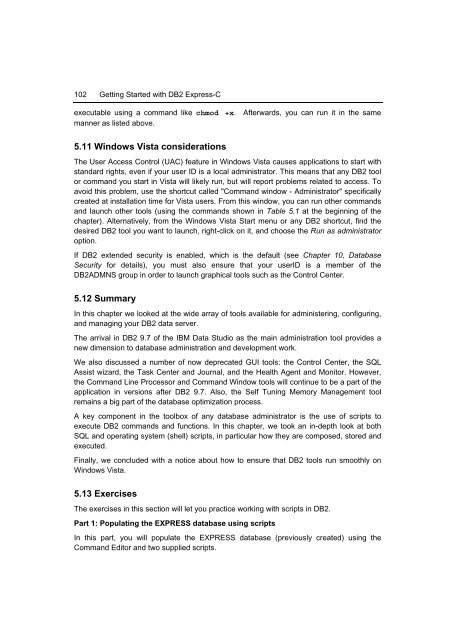Getting Started with DB2 Express-C
You also want an ePaper? Increase the reach of your titles
YUMPU automatically turns print PDFs into web optimized ePapers that Google loves.
102 <strong>Getting</strong> <strong>Started</strong> <strong>with</strong> <strong>DB2</strong> <strong>Express</strong>-C<br />
executable using a command like chmod +x. Afterwards, you can run it in the same<br />
manner as listed above.<br />
5.11 Windows Vista considerations<br />
The User Access Control (UAC) feature in Windows Vista causes applications to start <strong>with</strong><br />
standard rights, even if your user ID is a local administrator. This means that any <strong>DB2</strong> tool<br />
or command you start in Vista will likely run, but will report problems related to access. To<br />
avoid this problem, use the shortcut called "Command window - Administrator" specifically<br />
created at installation time for Vista users. From this window, you can run other commands<br />
and launch other tools (using the commands shown in Table 5.1 at the beginning of the<br />
chapter). Alternatively, from the Windows Vista Start menu or any <strong>DB2</strong> shortcut, find the<br />
desired <strong>DB2</strong> tool you want to launch, right-click on it, and choose the Run as administrator<br />
option.<br />
If <strong>DB2</strong> extended security is enabled, which is the default (see Chapter 10, Database<br />
Security for details), you must also ensure that your userID is a member of the<br />
<strong>DB2</strong>ADMNS group in order to launch graphical tools such as the Control Center.<br />
5.12 Summary<br />
In this chapter we looked at the wide array of tools available for administering, configuring,<br />
and managing your <strong>DB2</strong> data server.<br />
The arrival in <strong>DB2</strong> 9.7 of the IBM Data Studio as the main administration tool provides a<br />
new dimension to database administration and development work.<br />
We also discussed a number of now deprecated GUI tools: the Control Center, the SQL<br />
Assist wizard, the Task Center and Journal, and the Health Agent and Monitor. However,<br />
the Command Line Processor and Command Window tools will continue to be a part of the<br />
application in versions after <strong>DB2</strong> 9.7. Also, the Self Tuning Memory Management tool<br />
remains a big part of the database optimization process.<br />
A key component in the toolbox of any database administrator is the use of scripts to<br />
execute <strong>DB2</strong> commands and functions. In this chapter, we took an in-depth look at both<br />
SQL and operating system (shell) scripts, in particular how they are composed, stored and<br />
executed.<br />
Finally, we concluded <strong>with</strong> a notice about how to ensure that <strong>DB2</strong> tools run smoothly on<br />
Windows Vista.<br />
5.13 Exercises<br />
The exercises in this section will let you practice working <strong>with</strong> scripts in <strong>DB2</strong>.<br />
Part 1: Populating the EXPRESS database using scripts<br />
In this part, you will populate the EXPRESS database (previously created) using the<br />
Command Editor and two supplied scripts.

















